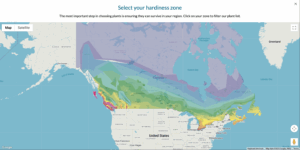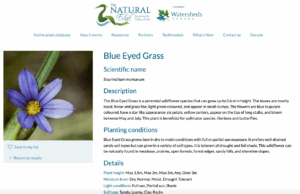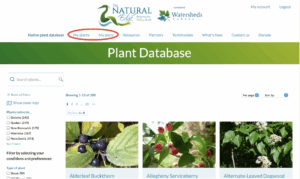by Paige Jessup, Climate Resilience Intern
What do you value most about your cottage? Maybe you like to go there and fish or swim, get out on the boat, or enjoy the quiet once you leave the city. In 2021, Watersheds Canada and Canadian Wildlife Federation conducted a survey to find out what shoreline property owners value most. The top three values selected were Water Quality, Swimming, and Scenery/View (Love Your Lake, 2021). However, most actions taken along the shoreline didn’t match with the values chosen by the survey respondents. We often see people turning to the modern practices of hardened shorelines by removing the natural vegetation and replacing it with retaining walls or armour stone, which create erosion in adjacent locations and negatively impact the littoral zone (Maximiliano-Cordova et al., 2019). This is to the detriment of wildlife habitat, water quality, and the very things we value most about our lakes.
The Natural Edge is a shoreline naturalization program that was designed for waterfront property owners to plant native trees, shrubs, groundcovers, wildflowers, and grasses along the water’s edge as a cost effective, nature-based solution. The program offers a free online Native Plant Database that was created to guide property owners across Canada in selecting suitable plant species based on their property’s site conditions and Canada’s plant hardiness zones.
By planting native plants along your shoreline, you are creating vital habitat for many different types of wildlife like fish, birds, frogs, and a variety of pollinators. These shorelines are used for food, shelter, breeding, and rearing of young. A healthy shoreline is vital to the overall health of lakes and other water bodies. Shorelines help filter out sediments and harmful pollutants, protect against shoreline erosion, mitigate flooding, and aid in maintaining or increasing your overall property value.
Native plants often require less maintenance than ornamental (non-native) plants because they are indigenous to that particular area. This means they have adapted to local conditions (Scholtens, 2021). They often have developed defences that allow them to coexist with each other and the surrounding environment. The Natural Edge’s Native Plant Database makes it easy to scroll through and pick your favorite plants and design a beautiful and aesthetically pleasing shoreline.
By changing our hardened shorelines to natural vegetation, we will see a healthy increase in fish and wildlife populations, improvement of the water quality, reduce the loss of property from erosion and overland runoff, and contribute to a healthy and vibrant lake community.
How to Use the Native Plant Database
To get started, go to The Natural Edge’s website and click on ” Native plant database“. You will first need to choose your hardiness zone based on where you will be planting. Using the map, click on your location. If the map does not automatically show on the screen, manually select it from the left menu by clicking “Show zone map”.

The Native Plant Database’s hardiness zone map helps you narrow down which native plant species will be well suited for your area.
Once you have selected your zone, scroll down to the filters on the left side of your screen. From there you can select your province, plant type, the moisture level of soil you will be planting in, your light conditions, and the soil conditions.

Be sure to filter your plant search by clicking your province/territory, plant type(s), and property conditions (moisture, light, soil).
Once you have chosen your filters, the Native Plant Database will show you which plants will be suitable based on your selections. You can click on any of the plants that have been filtered out for you and it will give you a brief description of the plant, a description of the ideal conditions the plant typically thrives in, and some more in-depth information such as plant height, depth, and species the plant will attract to your property.

When you click on a plant profile, you will find more information about it and what planting conditions it requires.
By registering an account, you will be able to save any plants you want to your account list. You will also be able to view any planting plans that are made for you if you choose to participate in a shoreline planting project through The Natural Edge. To see if there is a delivery partner in your area, please visit The Natural Edge’s website.

Creating a profile on The Natural Edge website is easy and free!
Have other questions about your shoreline property, which plants to select, or looking to book a site visit? Simply fill in this form and we will get back to you!
References
Love Your Lake. (2021). 2013-2021 summary report. Watersheds Canada. Retrieved from: https://watersheds.ca/our-impact
Maximiliano-Cordova, C., Salgado, K., Martínez, M.L. et al. Does the Functional Richness of Plants Reduce Wave Erosion on Embryo Coastal Dunes?. Estuaries and Coasts 42, 1730–1741 (2019). https://doi-org.proxy.lib.uwaterloo.ca/10.1007/s12237-019-00537-x
Scholtens, P. (2021). Why Grow Native Plants? Canadian Wildlife Federation. Retrieved from: https://cwf-fcf.org/en/news/articles/why-grow-native-plants.html
